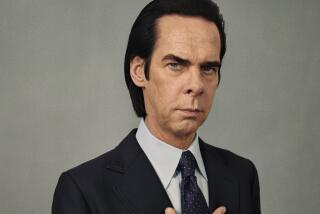ROCK ‘N’ REEL: A NEW TACK ON SOUND TRACKS
I enjoy putting together Top 10 album lists so much that I’ve found a way to stretch it into a yearlong process. Every time an album arrives that I like, I place it on an office shelf in order of preference, so that I can see my current Top 10 at any given moment during the 12 months.
In view of all this time devoted to a Top 10, I was surprised to see Ry Cooder’s “Alamo Bay” sound track on Time magazine’s Top 10 albums of 1985.
The reason for the surprise: I had played “Alamo Bay” often during the year and enjoyed it, but never even thought about putting it on my shelf. The same with a second Cooder sound track from 1985: “Paris, Texas.” I’ve generally thought of sound tracks as a breed apart--albums whose primary intent was to serve the film, not the pop audience.
Playing the albums again, I realized, however, there is a whole history of worthy sound-track recordings that deserve to be considered in a wider pop context--albums by Cooder (including “The Long Riders” and “The Border”) and other pop/rock figures--notably Randy Newman, Jack Nitzsche, Mark Knopfler and Tangerine Dream.
Together, they compose what we might describe as the hidden jewels in the rock ‘n’ reel connection.
In the ‘50s and ‘60s, rock fans learned to pretty much stay clear of sound-track recordings. They’d buy them to get a particular theme song or hit single, and find the rest of the LP to be simply background orchestral music without pop-rock sensibilities. The rule became: Just buy the single.
Even when pop and rock artists began contributing heavily to movie scores, the LPs didn’t usually reflect the consistency and punch of the same artists’ regular collections. Examples: Simon & Garfunkel’s “The Graduate” and Bob Dylan’s “Pat Garrett & Billy the Kid.”
Today, this process has been reversed.
The aim with a high percentage of sound-track records today is almost solely to fuel the pop-rock sensibilities that these albums once ignored. This trend, which just packs tunes by various artists together in hopes of getting some hit singles, has been bad for movies (the music does little to enhance the dramatic purpose of the film) and for the pop audience (so many of these collections are middle-brow in tone).
Between the extremes, however, some pop artists have given us sound-track albums that both meet the needs of the film and stand up outside of it as valid music.
Among the many sound-track recordings that worked well beyond the films and enjoyed considerable commercial success are such varied projects as Curtis Mayfield’s powerful and dark “Superfly,” “Saturday Night Fever” (an ambitious blend of original Bee Gees tunes, previously released tracks by other artists and additional music and adaptations by David Shire), Giorgio Moroder’s tense, synthesizer-accented “Midnight Express” and Stevie Wonder’s inspiring “Journey Through the Secret Life of Plants.” (Many sound-track albums, purists will note, contain additional music that didn’t actually appear in the film.)
There is an equally valuable group of sound-track albums that failed to capture the attention of the mass pop audience. The best moments of these LPs reflect the character and special vision that is the hallmark of all prized pop works.
Cooder, a Los Angeles guitarist who has been affiliated with such diverse rock forces as Captain Beefheart and the Rolling Stones, has such a solid feel for basic American musical forms--including gospel--that he even sat in as guest soloist when the widely praised “The Gospel at Colonus” production opened last month at the James A. Doolittle Theatre in Hollywood.
In his movie scores, Cooder mixes country, blues, soul and rock styles into a rich blend of grass-roots Americana. The moody, chiefly instrumental approach is flexible enough in most of the film to convey both the romanticism of people who cling to the nation’s independent spirit and the darker, violent side of that same frontier instinct.
Because Louis Malle’s film “Alamo Bay” deals with exactly that conflict, it’s easy to see why Cooder was chosen to do the music. The album (on Slash Records) opens with a wistful, guitar-honed suggestion of the lingering potential of the American Dream, but gives way rapidly to the explosive frustration of Texas fishermen who resent the economic competition of Vietnamese refugees. Elsewhere, the LP moves from a wary, country-flavored love song (sung by John Hiatt and actress Amy Madigan) to the combative “The Last Stand” (featuring an appropriately agitated vocal by Fear’s Lee Ving).
“Paris, Texas” (Warner Bros.) is an even moodier expression of the psychological dislocation that is at the heart of Wim Wenders’ film. Though further from pop accessibility than “Alamo Bay,” the score may be an even more affecting work because so much of it is told simply through guitar-shaped portraits that are as softly searching and gently probing as the film itself.
While the brightly designed Old West textures of “The Long Riders” and the rugged intensity of “The Border” are also recommended, these two recent Cooder collections provide the most helpful introduction to today’s look at hidden jewels.
These other key links in the rock ‘n’ reel connection are limited to albums that never made the Billboard Top 100 sales chart (most never even made the Top 200). The list, which is chronological, is also limited to one LP per artist/composer.
“Performance,” Jack Nitzsche (Warner Bros., 1970)--Long prized by Stones cultists because the film--an especially unsettling if frequently pretentious look at moral disintegration--presents Mick Jagger in a role that exaggerates all the perverse implications of the Stones’ late-’60s image. It also features “Memo From Turner,” a typically mocking, irreverent Jagger-Richards tune. But there is far more than that song to enjoy on the sound-track LP.
Nitzsche, who has gone on to do scores in both the traditionally orchestrated style of “One Flew Over the Cuckoo’s Nest” and the rock-oriented song approach of “Cruising” (another overlooked jewel), wrote much of the music and produced the album. Randy Newman sang lead on one selection and conducted the orchestra on others, while Cooder’s bottleneck guitar playing gives the music its dominant color.
“The Harder They Come,” various artists (Mango, 1972)--I almost left this off the list because it has become so well known as one of the essential reggae collections that it hardly seems “hidden.” But the package didn’t crack the Top 100 the year it was released, so the stirring statement of determination and salvation qualifies. Jimmy Cliff’s own tunes are augmented by recordings of the Maytals, the Slickers, the Melodians and Desmond Dekker.
“O Lucky Man!,” Alan Price (Warner Bros., 1973)--There’s a lively English music-hall feel here as Price, a valuable though infrequent record maker since his days with the Animals, mixes sarcasm and optimism in these witty, disarming songs from Lindsay Anderson’s biting film about ambition and power. Besides writing and performing the music, Price appears in the film with his band.
“Sorcerer,” Tangerine Dream (MCA, 1977)--This German synthesizer band has returned with other scores (most notably “Thief”), but this one for the William Friedkin remake of the French thriller “The Wages of Fear” largely defines the tense, pulsating style that Giorgio Moroder expanded upon and popularized in later films like “Midnight Express,” “American Gigolo” and “Cat People.” Side note: I used to favor Tangerine Dream’s German synthesizer rival, Kraftwerk, because of the humor and broader pop instincts in that band’s work, but Dream’s music has a tighter and more rigid focus that is holding up better.
“Ragtime,” Randy Newman (Elektra, 1981)--Newman’s first score was for “Cold Turkey,” a quirky, quickly forgotten early-’70s Norman Lear film about a town trying to win millions of dollars by making everyone refrain from smoking for a month. If a sound-track recording was even released (Newman’s wonderfully ironic “He Gives Us All His Love” was in the film), I haven’t been able to find it. But “Ragtime” is an impressive, mature work that earned Newman an Oscar nomination.
Where Cooder and Tangerine Dream are
asked to adapt their defined styles to a film, Newman--the latest dividend from the clan that also gave us composers Alfred and Lionel--is more like mainstream film composers who are asked to draft traditionally orchestrated scores. For “The Natural” (Warner Bros., 1983), Newman steps beyond the ragtime-era confines of this score to even richer musical terrain, but this work features a peppier and more accessible tone.
“One From the Heart,” Tom Waits (Columbia, 1982)--The best tunes here abound with a sophistication and style rarely found anymore in Hollywood musicals (indeed, true Hollywood musicals themselves are hard to find). The elegance and detail in songs like “Old Boyfriends” and “Broken Bicycles” add information and heart to Francis Coppola’s romantic fantasy about people trying to find a place for themselves once their grandest dreams have become unraveled.
The wonder of the film and the score is that Waits’ gruff vocal style works so well alongside the more pristine approach of country-spawned vocalist Crystal Gayle. The latter is marvelous in both duets and on her own when she is singing lines like these: “I can clearly see nothing is clear/I keep falling apart every year/Let’s take a hammer to it/There’s no glamour to it/Is there any way out of this dream?”
“Local Hero,” Mark Knopfler (Warner Bros., 1983)--The loveliness and warmth of Knopfler’s music beautifully accents the peaceful-village charm celebrated in Bill Forsyth’s film, and that warmth transfers nicely to record. There’s a richness and originality of spirit in Knopfler’s guitar playing here that sounds more deeply rooted and personal than his work with Dire Straits. Also noteworthy: Knopfler’s ethereal “Cal” (Mercury, 1984).
“Rumble Fish,” Stewart Copeland (A&M;, 1983)--Police drummer Copeland transfers some of the percussive aspects of his work with that band to this nervous, energetic, pointillistic score. Beyond proving that the Police isn’t just a Sting operation, Copeland gives us the most experimental and contemporary-sounding of these hidden jewels. A work of considerable imagination and spark.
More to Read
The biggest entertainment stories
Get our big stories about Hollywood, film, television, music, arts, culture and more right in your inbox as soon as they publish.
You may occasionally receive promotional content from the Los Angeles Times.










